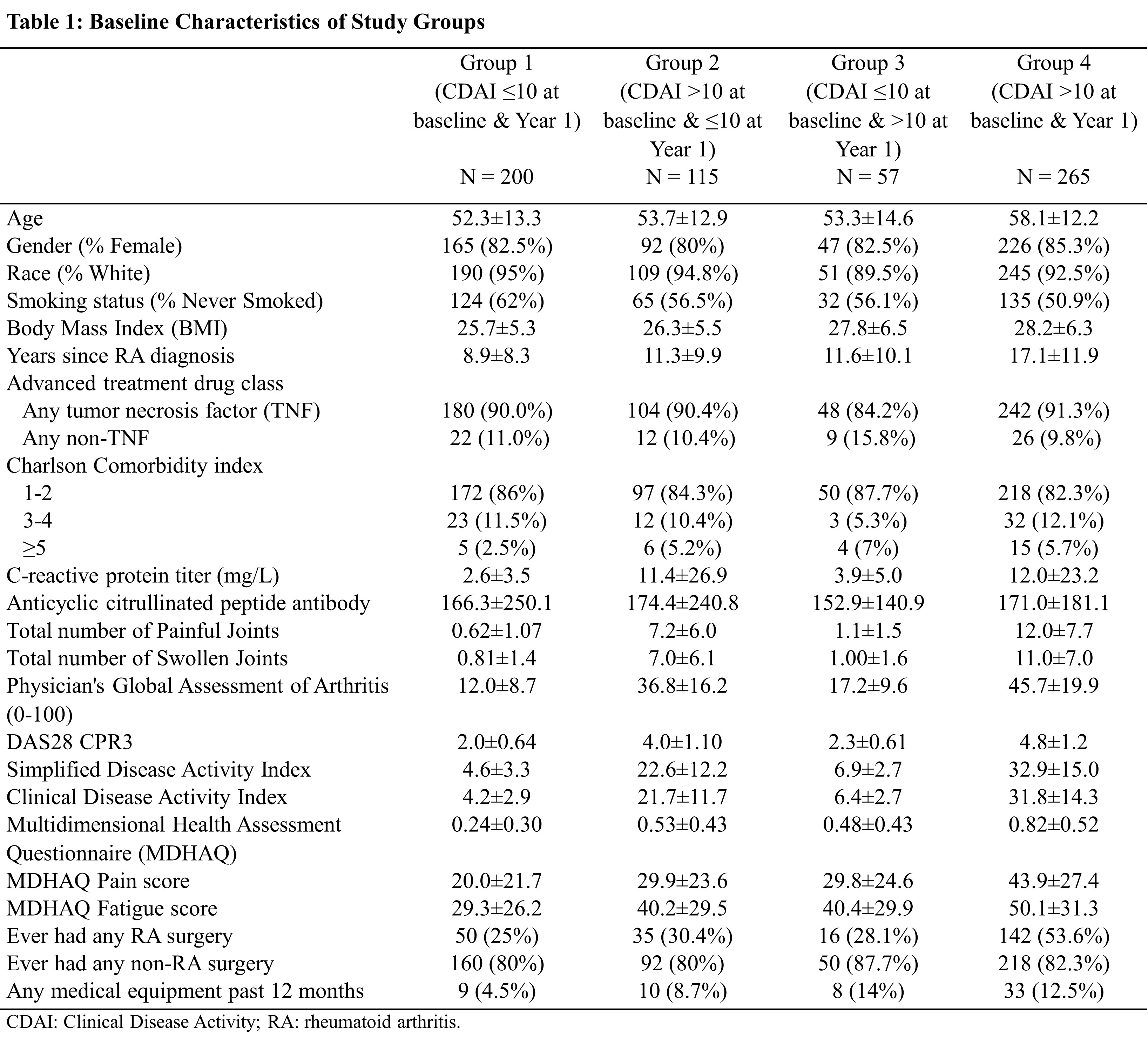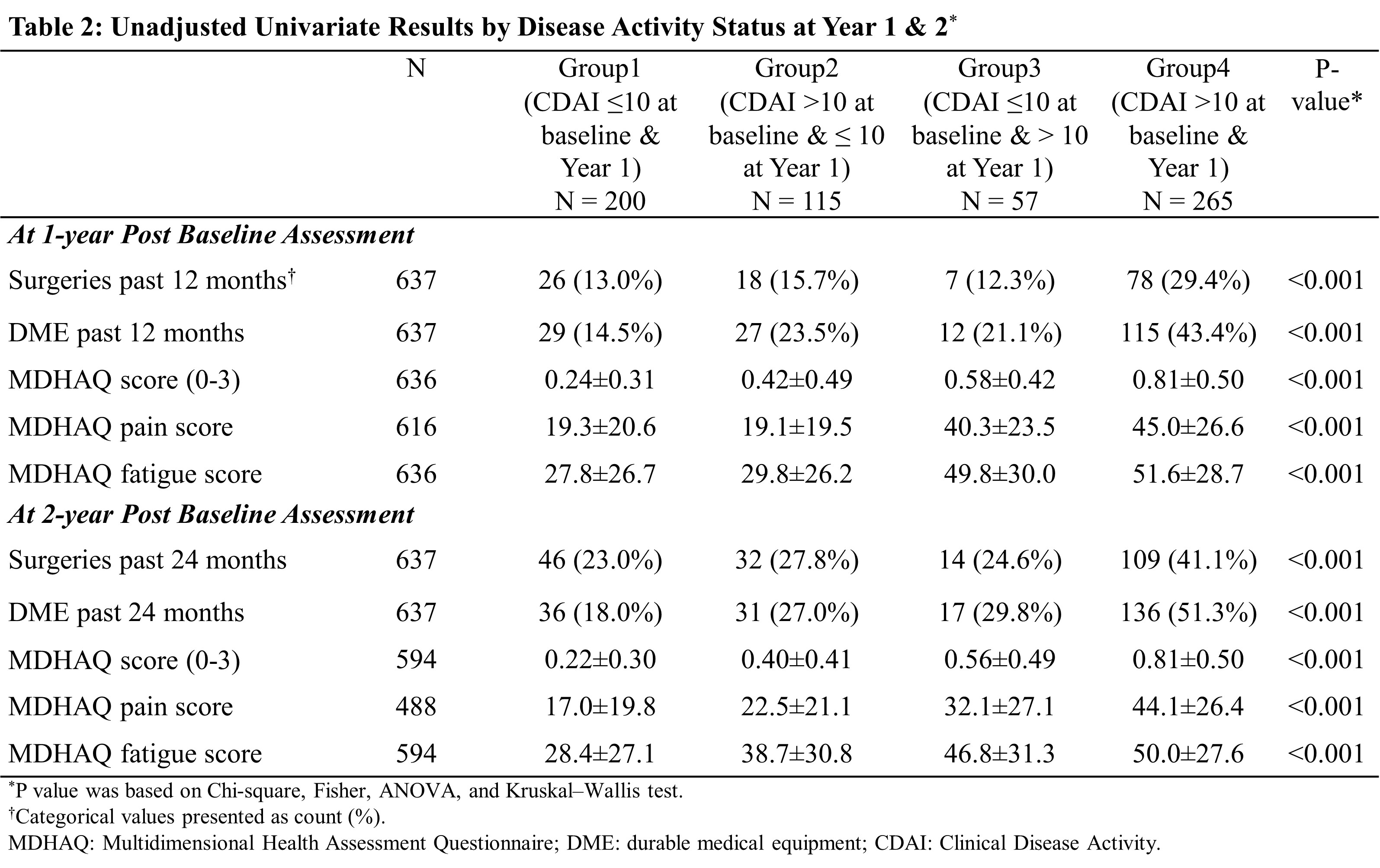Session Information
Session Type: Poster Session B
Session Time: 10:30AM-12:30PM
Background/Purpose: Despite scientific advances and the availability of new treatments for rheumatoid arthritis (RA), many RA patients still cannot achieve the therapeutic goal of low disease activity (defined as Clinical Disease Activity Index [CDAI] ≤10). The aim of this study was to assess the effect of maintaining, attaining, or losing treatment goals of low disease activity on patient reported outcomes (PROs) and health care resource use (HCRU) among patients receiving advanced treatment for RA.
Methods: Data from the Brigham and Women’s Hospital Rheumatoid Arthritis Sequential Study (BRASS), a prospective registry of 1,581 adult RA patients with established or recent onset of RA were analyzed. Out of 1,581 patients, 1,478 (93%) satisfied ACR 1987 criteria at baseline. 437 enrollees have been assessed using the ACR 2010 criteria and 345 (79%) patients were classified as definite RA. Patients exposed to advanced treatment were classified into 4 groups according to their CDAI scores (≤ 10 vs >10) at baseline and after one year of follow-up. Baseline was defined as the first record with evidence of exposure to biologic disease-modifying antirheumatic drugs (bDMARDs) in BRASS. PROs including Multidimensional Health Assessment Questionnaire (MDHAQ) overall, pain, fatigue scores and proportions of patients with surgeries and durable medical equipment (DME) use in year 1 and year 2 were assessed. Multivariable regression analyses adjusted for baseline age, gender, RA duration, Charlson comorbidity index and disease activity were performed.
Results: Data from a total of 637 patients receiving advanced therapy were analyzed. At baseline, 257 (40%) patients were at low disease activity target (CDAI ≤10). Of these patients, 57 (22%) lost treatment target and had CDAI >10 after 1 year. Of the 380 patients who had CDAI >10 at baseline, 115 (30%) attained low disease activity after one year. Patients who did not achieve low disease activity consistently were older, had longer history of RA, greater number of painful and swollen joints and higher Charlson comorbidity index at baseline than patients who were consistently at low disease activity over study period. Patients who were not able to attain low disease activity during study period had higher risk of surgery (adjusted OR=2.2 at year 1 and adjusted OR= 1.7 at year 2), DME use (adjusted OR=2.5 at year 1 and adjusted OR=2.5 at year 2), higher MDHAQ overall (Δ= +0.14 at year 1, +0.17 at year 2), pain (Δ = +14.95 at year 1, +13.79 at year 2) and fatigue (Δ = +10.31 at year 1, +8.46 at year 2) scores compared to patients who were consistently at low disease activity of CDAI ≤10.
Conclusion: Current study findings suggest maintaining low disease activity level is challenging for many patients receiving advanced therapy. Lowering RA disease activity offers the potential to reduce health care resource utilization and improve patient functioning. There is a need for more effective treatments and management to get more RA patients into treatment target.
To cite this abstract in AMA style:
Sbarigia U, Zhao J, Kwong J, Naik C, Zazzetti F, Shadick N, Weinblatt M. Impact of Maintaining Low Disease Activity on Patient Outcomes and Healthcare Resource Utilization in Rheumatoid Arthritis Patients Receiving Advanced Treatment [abstract]. Arthritis Rheumatol. 2024; 76 (suppl 9). https://acrabstracts.org/abstract/impact-of-maintaining-low-disease-activity-on-patient-outcomes-and-healthcare-resource-utilization-in-rheumatoid-arthritis-patients-receiving-advanced-treatment/. Accessed .« Back to ACR Convergence 2024
ACR Meeting Abstracts - https://acrabstracts.org/abstract/impact-of-maintaining-low-disease-activity-on-patient-outcomes-and-healthcare-resource-utilization-in-rheumatoid-arthritis-patients-receiving-advanced-treatment/



